|
|
|
Sort Order |
|
|
|
Items / Page
|
|
|
|
|
|
|
| Srl | Item |
| 1 |
ID:
160990


|
|
|
|
|
| Summary/Abstract |
With the continued use of unsafeguarded naval nuclear-propulsion programs in all nuclear-weapon states, the commissioning of an Indian nuclear submarine, and the potential investment in such programs by non-nuclear-weapon states including Brazil and South Korea, movement toward a regulatory regime for nuclear material in the naval sector has become imperative. Such a framework faces a recurring debate on adequately protecting sensitive military technology while delivering assurances that naval nuclear material is not diverted to nuclear-weapon programs. In this viewpoint, we examine various prospective mechanisms to regulate naval nuclear stocks and assess them in terms of their effectiveness and scope. Drawing on lessons from the drafting, negotiation, and implementation of the Model Additional Protocol, we recommend a safeguards regime for naval nuclear material via a protocol that supplements the existing global nuclear-governance system. This protocol provides a standardized yet flexible approach to naval nuclear-material safeguards across all states (whether nuclear-weapon states, non-nuclear-weapon states, or outside the Treaty on the Non-Proliferation of Nuclear Weapons) to handle variations among naval nuclear fuel cycles and technologies.
|
|
|
|
|
|
|
|
|
|
|
|
|
|
|
|
| 2 |
ID:
169455


|
|
|
|
|
| Summary/Abstract |
Nuclear disarmament is often seen as eventually requiring access to nuclear warheads or to the warhead-dismantlement process to verify that a state has not hidden weapons or weapon-materials despite promising to disarm. This article suggests this view is misplaced, and that what is needed is a verification mechanism able to provide reliable assurances of the absence of fissile materials available for use in weapons after a state has disarmed. Such a mechanism will need an initial declaration of the amount of fissile materials held by a state for all purposes, military and civilian. In a state with a nuclear arsenal awaiting elimination, this declaration would have to include materials that may not be available for verification because they are in nuclear weapons or are in other classified or proliferation-sensitive forms. This article describes a verification arrangement that does not require access to materials in weapons and in sensitive forms while still allowing checks on the overall accuracy of the declaration. Verification of the completeness and correctness of the declaration is deferred to the time when the weapons-relevant material enters the disposition process, at which point it no longer has any sensitive attributes. By removing the focus on monitoring warheads and dismantlement, this new approach could provide a more manageable path to nuclear disarmament.
|
|
|
|
|
|
|
|
|
|
|
|
|
|
|
|
| 3 |
ID:
169456


|
|
|
|
|
| Summary/Abstract |
Researchers have recently proposed a new approach to nuclear-arms-control verification, dubbed “deferred verification.” The concept forgoes inspections at sensitive nuclear sites and of nuclear weapons or components in classified form. To implement this concept, a state first divides its nuclear program into a closed segment and an open segment. The total fissile-material inventory in the closed segment, which includes the weapon complex, is known and declared with very high accuracy. Essentially no inspections take place in the closed segment. In contrast, inspectors have access to the open segment, which includes in particular the civilian nuclear sector. The fissile-material inventory in the open segment is known with less accuracy, but uncertainties can be reduced over time using nuclear-archaeology methods. Deferred verification relies primarily on established safeguards techniques and avoids many unresolved verification challenges, such as the need for information barriers for warhead confirmation measurements. At the same time, deferred verification faces some unique challenges. Here, we explore some of these challenges and offer possible solutions; to do so, we examine possible noncompliance strategies in which a state would seek to withhold a higher-than-declared inventory.
|
|
|
|
|
|
|
|
|
|
|
|
|
|
|
|
| 4 |
ID:
128074
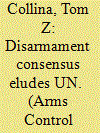

|
|
|
|
|
| Publication |
2013.
|
| Summary/Abstract |
As they complete their annual debate on disarmament and international security, the member states of the United Nations continue to struggle to agree on where to focus their efforts. The next logical step for many, a global ban on the production of fissile materials for nuclear weapons, has been effectively blocked by Pakistan.
Meanwhile, international support is growing to move directly to the elimination of nuclear weapons, which the declared nuclear powers oppose.
|
|
|
|
|
|
|
|
|
|
|
|
|
|
|
|
| 5 |
ID:
075373
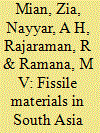

|
|
|
|
|
| Publication |
2006.
|
| Summary/Abstract |
The July 2005 U.S.-India joint statement represents a fundamental transformation of U.S.-India relations and at the same time a challenge to the disarmament and non-proliferation regimes. There is concern that the March 2006 separation plan proposed by India for demarcating its military and civilian nuclear facilities may allow a potentially rapid expansion of its capacity for fissile material production for weapons. In this analysis, we have assessed fissile material production capabilities in India and how they might change as a result of the U.S.-India deal. We look at current stockpiles of fissile materials in India and Pakistan and estimate the changing capacity for future fissile material production as India progressively places some of its heavy water reactors under safeguards. We assess India's uranium resource constraints and the additional weapons grade plutonium production in its unsafeguarded heavy water power reactors that would be made possible by imports of uranium allowed by the deal. We also estimate the weapons plutonium production from India's fast breeder reactor that is under construction and is to be unsafeguarded.
|
|
|
|
|
|
|
|
|
|
|
|
|
|
|
|
| 6 |
ID:
160987


|
|
|
|
|
| Summary/Abstract |
While the nonproliferation community has long acknowledged the possibility of nuclear terrorism, its prevention has become a central focus area in recent years. For decades it has been assumed that, with access to special nuclear material (SNM), the steps to indigenously develop an improvised nuclear device are within the reach of non-state actors. At the same time, indigenous production of SNM has generally been dismissed as infeasible. Recognizing how recent trends of technology democratization, the open exchange of information, and globalization have eroded certain barriers to proliferation by non-state actors, this research explores the pathways a non-state actor could take to indigenously develop SNM and develops a method to determine the comparative attractiveness of each pathway, given the current capabilities of non-state actors. Additionally, it considers avenues for further investigation to identify countermeasures for SNM production, including countermeasures specific to non-state actors.
|
|
|
|
|
|
|
|
|
|
|
|
|
|
|
|
| 7 |
ID:
066987
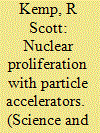

|
|
|
| 8 |
ID:
096497
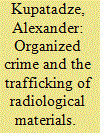

|
|
|
|
|
| Publication |
2010.
|
| Summary/Abstract |
Based on unique empirical data, including interviews with smugglers of radiological materials and the investigators who track them, this article discusses nuclear smuggling trends in the former Soviet republic of Georgia. Smuggling in Georgia mainly involves opportunist smugglers and amateurs, as opposed to professional criminals and terrorists; however, this does not mean that radiological smuggling is devoid of professionalism or organization. The article demonstrates that professional criminals are rarely involved in smuggling due to the unreliable nature of the market for radiological materials and the threat radiological smuggling could pose to professional criminals' ability to wield political power and operate legal commercial enterprises.
|
|
|
|
|
|
|
|
|
|
|
|
|
|
|
|
| 9 |
ID:
099518
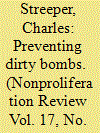

|
|
|
|
|
| Publication |
2010.
|
| Summary/Abstract |
Radioactive sealed sources have a long history and a much wider worldwide distribution than do weapons-usable fissile materials. This article compares the mechanisms for controlling radioactive sources with those of weapons-usable materials and makes the case for improved policy making on the safe and secure management of radioactive sources (often referred to simply as "sources"). Such sources have been widely distributed with commercial and government support to nearly every country, yet there are no legally binding, international agreements or regulations to control any aspect of their life cycle. This is problematic because some sources that are disused, abandoned, or otherwise fall out of regulatory control could be used in the form of a radiological dispersal device (RDD, or dirty bomb). An RDD could pose significant economic and psychological impacts with the potential for detrimental effects on public health. The lack of international measures to control sources is troubling for several reasons: creating an RDD is much easier than fashioning a nuclear weapon from scratch or from stolen fissile materials; given the many incidents involving diversion from regulatory control and the misuse of sources, an RDD attack would be one of the more likely scenarios; materials security for sources is generally weak and inconsistent; it is nearly impossible to determine the total amount of sources manufactured and distributed; used sources are frequently found uncontrolled and transiting borders, and penalties are light at best; the market-based supply and demand of sources facilitates their rapid and loosely regulated distribution; and the "peaceful uses" aspect of the Treaty on the Non-Proliferation of Nuclear Weapons along with norms that began developing around the time of Atoms for Peace have promoted the nearly unchecked global distribution of sources. Several immediate and long-term actions are suggested to reduce the threat posed by radiological sources.
|
|
|
|
|
|
|
|
|
|
|
|
|
|
|
|
| 10 |
ID:
166863
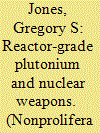

|
|
|
|
|
| Summary/Abstract |
The claim that reactor-grade plutonium cannot or will not be used to produce nuclear weapons has been used to justify non-nuclear-weapon states’ large stockpiles of plutonium that has been separated from highly radioactive spent fuel. However, by using reduced-mass plutonium cores, it is possible to manufacture reliable nuclear weapons with reactor-grade plutonium. These weapons can have the same design, size, weight, and predetonation probability as weapons using weapon-grade plutonium and would require no special cooling. The increased radiation from reactor-grade plutonium could be easily managed by shielding and operational procedures. Weapons using plutonium routinely produced by pressurized-water reactors could have a lethal area between 40 percent and 75 percent that of weapons using weapon-grade plutonium. In the past, both Sweden and Pakistan considered using reactor-grade plutonium to produce nuclear weapons, and India may be using reactor-grade plutonium in its arsenal today. Despite claims to the contrary, the United States used what was truly reactor-grade plutonium in a successful nuclear test in 1962. The capability of reactor-grade plutonium to produce highly destructive nuclear weapons leads to the conclusion that the separation of plutonium, plutonium stockpiling, and the use of plutonium-based fuels must be phased out and banned.
|
|
|
|
|
|
|
|
|
|
|
|
|
|
|
|
| 11 |
ID:
143303
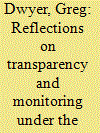

|
|
|
|
|
| Summary/Abstract |
The 1993 Highly Enriched Uranium (HEU) Purchase Agreement between the United States and Russian Federation is often described as one of the world's most successful nuclear nonproliferation programs. In 2013, the two states achieved the agreement's major goals of downblending 500 metric tons of Russian weapon-origin HEU to low enriched uranium (LEU) and delivering all resultant LEU to the United States. At one time, the LEU delivered under the agreement generated nearly 10 percent of all electricity in the United States. The agreement achieved its nonproliferation goals through a unique government/industry partnership. Commercial executive agents contracted for the annual sale and delivery of downblended LEU, while the US and Russian governments exercised reciprocal transparency monitoring measures to demonstrate that all LEU delivered under the agreement was derived from Russian weapons-origin HEU, and that the same LEU was used for exclusively peaceful purposes in the United States. The commercial development, negotiations, and implementation of the agreement have been well documented. This article describes the scope of US transparency monitoring activities in Russian HEU processing facilities, as well as Russian monitoring in the United States. In addition, it discusses the results of twenty years of reciprocal transparency monitoring and data analysis, and outlines lessons learned that are potentially applicable to future transparency monitoring and verification regimes and similar cooperative efforts.
|
|
|
|
|
|
|
|
|
|
|
|
|
|
|
|
| 12 |
ID:
140982
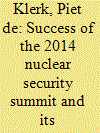

|
|
|
|
|
| Summary/Abstract |
The 2014 Nuclear Security Summit (NSS) in The Hague was a resounding success, both in organizational terms and in terms of substance. The new substance can be found in the Communiqué, as well as in innovative joint statements by participants, all of which may be considered as implementation of actions decided upon in the Final Document of the 2010 Review Conference of the Treaty on the Non-Proliferation of Nuclear Weapons. The next two years in the NSS process cannot be business as usual. This viewpoint makes some suggestions for NSS states to undertake between now and the final summit in 2016, including preparations for winding down the NSS process as we know it.
|
|
|
|
|
|
|
|
|
|
|
|
|
|
|
|
| 13 |
ID:
144285
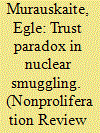

|
|
|
|
|
| Summary/Abstract |
This article explores the paradox of trust in the largest nuclear smuggling operation involving highly enriched uranium (HEU) discussed in open source literature. In the first effort to understand the type, extent, and role of trust in nuclear smuggling enterprises, it draws from literature on trust development in legitimate businesses as well as criminal enterprises. Observed behavioral patterns in this case challenge traditional notions of the internal dynamics of temporary groups engaged in nuclear smuggling and operational realities of such activities. The article seeks to explain why individuals agree (and continue) to operate in this high-risk environment, unbound by close personal ties, without any effort to verify the background, motives, or qualifications of the fellow conspirators. It offers ways to advance current nonproliferation efforts in non-state actor interdiction by exploiting the environment of shallow trust in temporary groups.
|
|
|
|
|
|
|
|
|
|
|
|
|
|
|
|
|
|
|
|
|